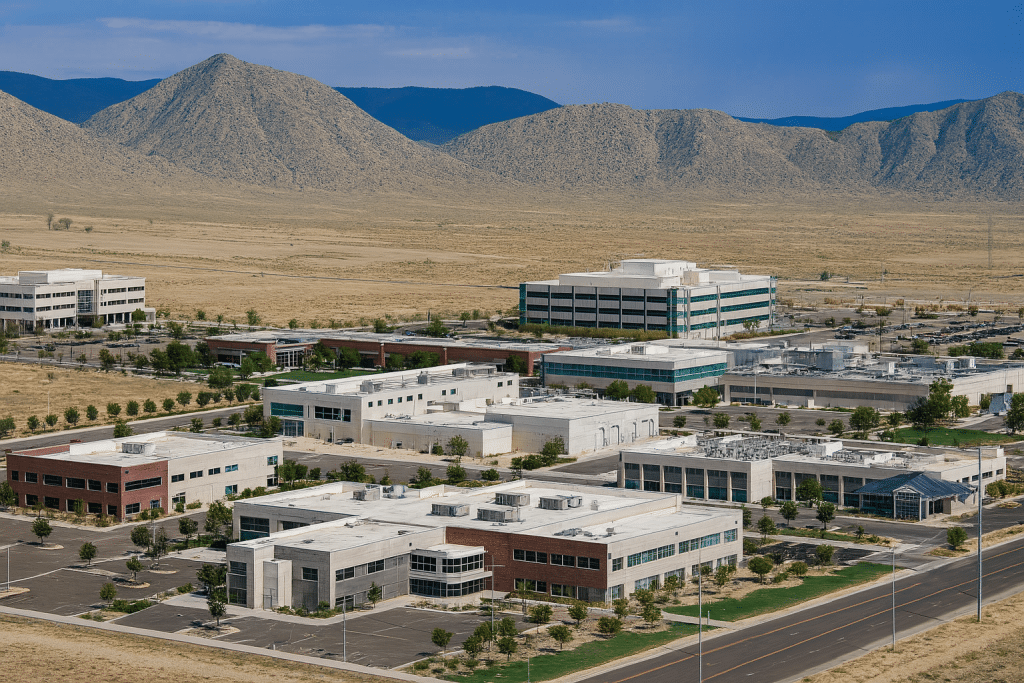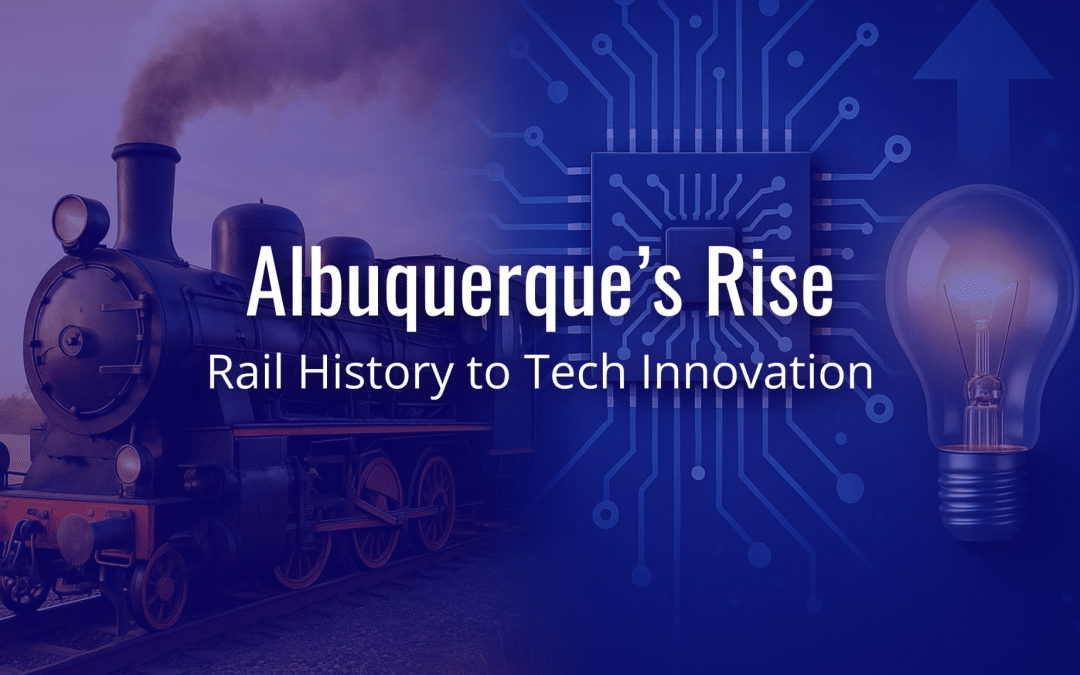The Story of Albuquerque’s Transition from Rail Town to Tech Hub
From the steam engines of the 1900s to startups pitching ideas over coffee today, Albuquerque’s story is one of reinvention. Once a rail town, then a defense hub, the city is now carving out a name in tech and innovation.
By tracing Albuquerque’s economic transformation, we see how tech-driven growth can emerge, even in smaller cities outside the usual innovation hotspots.
It Started With the Tracks: Albuquerque’s Rail Town Era
Albuquerque owes much of its early growth to the arrival of the Atchison, Topeka & Santa Fe Railway in 1880. This development shifted economic activity eastward, away from the Old Town settlement, and helped establish New Town Albuquerque, which we now know as the downtown area.
The railroad wasn’t just a mode of transportation; it was an industry that brought jobs, infrastructure, and lifestyle changes. The Albuquerque Rail Yards became a bustling hub of activity, housing massive maintenance shops, warehouses, and service facilities that operated like a city within a city.
At its peak, the railway employed nearly a quarter of Albuquerque’s workforce. Landmarks like the famed Alvarado Hotel served travelers and symbolized the city’s growth. The rhythms of train whistles and the bustle of crew changes ingrained movement and logistics into Albuquerque’s identity.
Yet, as diesel engines replaced steam by the 1950s, the city’s reliance on rail dwindled, and the once-busy Rail Yards gradually fell silent, marking a shift toward economic diversification.
Defense Spending and Scientific Research Take the Lead
The mid-20th century saw a seismic shift in Albuquerque’s economy with federal investment in defense and scientific research. During and after World War II, New Mexico’s involvement in the Manhattan Project paved the way for the creation of major institutions like Kirtland Air Force Base and Sandia National Laboratories.

These facilities brought an influx of engineers, physicists, and military personnel, transforming Albuquerque into a hub of innovation. Kirtland became one of the largest military bases in the country, and Sandia Labs evolved into a leading center for national security and cutting-edge research.
This period not only stabilized the local economy but also planted the seeds for a workforce skilled in science, technology, and engineering. These professionals provided the backbone for industries that would later lead Albuquerque’s push into the tech space.
The Rise of Research and Innovation Institutions
By the late 20th century, Albuquerque began leveraging its existing research infrastructure to foster a spirit of entrepreneurship and innovation. The University of New Mexico (UNM) expanded its focus on STEM disciplines, creating tech-transfer programs like STC.UNM (now UNM Rainforest Innovations) to help commercialize university research.
Innovate ABQ, a seven-acre innovation district in downtown Albuquerque, further connected academic research to entrepreneurial ventures. Joining forces with institutions like Central New Mexico Community College (CNM), the region began reimagining itself as a cradle for startups, with initiatives focused on coding, IT, and business development.
These partnerships between academia, government labs, and startups created a ripple effect, laying the foundation for Albuquerque’s emerging tech ecosystem.
Private Sector Growth and the Local Startup Scene
Over the past two decades, Albuquerque has seen noteworthy growth in its private tech sector. Startups like RS21, known for data visualization, and Build With Robots, a company automating industrial tasks, stand out as examples of innovation rooted in the city. Firms in cybersecurity, clean energy, and aerospace are also gaining traction.
Spaces like FatPipe ABQ and The BioScience Center offer affordable coworking and incubation spaces tailored to entrepreneurs. These hubs provide not just office space, but also mentorship, networking opportunities, and access to venture funding.
City-led initiatives and grants further bolster these burgeoning businesses, proving that local governance is a key ally in Albuquerque’s transformation.
Railyards to Tech District: Symbolic and Structural Changes
Perhaps no location better symbolizes Albuquerque’s evolution than its iconic railyards. Once a bustling hub of industrial activity, the railyards have reemerged as a focal point for community revitalization and modern use. Events like the Rail Yards Market and public redevelopment projects have breathed new life into this historic site.

As Albuquerque pivots toward a tech-driven future, efforts are underway to convert industrial spaces into innovation zones. The railyards stand as a bridge between the city’s industrial past and its ambitions as a modern tech hub. Their preservation and repurposing embody the broader economic shift from manufacturing to knowledge work.
What’s Next? Challenges and Opportunities for Tech in Albuquerque
Despite notable progress, Albuquerque faces a mix of hurdles and opportunities as it continues to grow its tech industry.
Challenges like limited access to venture capital, gaps in broadband infrastructure, and retaining local graduates in-state persist. The city still grapples with “brain drain,” where talent often leaves for larger, better-funded metros.
However, Albuquerque’s strengths, including its affordability, proximity to national labs, and quality of life, remain significant draws for businesses and individuals. Remote work and hybrid job models offer new opportunities for recruitment and collaboration, while public-private partnerships continue to attract investment.
For Albuquerque to cement its reputation as a tech hub, it must focus on nurturing its existing talent pool, investing in infrastructure, and building stronger ties within its evolving tech ecosystem.
From Tracks to Tech: Albuquerque’s Story Is Still Moving
Albuquerque’s transformation from a rail town to a tech hub isn’t a story of reinvention. It’s a continuation of its legacy as a city defined by movement, engineering, and innovation. The railyards that once brought employment remain a physical reminder of the city’s industrial roots. Now, they coexist with coworking spaces and research institutions that drive the tech scene.
The evolution of Albuquerque shows us that innovation doesn’t have to come from scratch and doesn’t have to happen within Silicon Valley. It grows in layers, built on the efforts of past industries and the people who push for what’s next.
Whether you’re a tech enthusiast, a historian, or an entrepreneur searching for opportunities, Albuquerque offers a front-row seat to a city shaping its future. Stay curious, or better yet, become part of the story.

